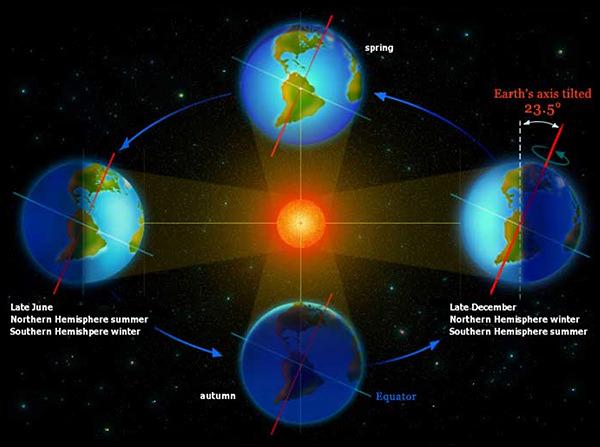What determines sunset times?
Sunset times are primarily influenced by three key factors: Earth's axial tilt, its elliptical orbit around the Sun, and the implementation of daylight saving time. The axial tilt of Earth leads to varying the angle of the Sun's rays at different times of the year, altering when the Sun sets based on the season. During summer in the Northern Hemisphere, the north pole is tilted towards the Sun, resulting in later sunsets due to the extended daylight hours. In contrast, winter sees earlier sunsets as the pole tilts away.
The elliptical shape of Earth's orbit also plays a role, causing the Sun's apparent speed in the sky to vary at different times of the year. When the Earth is closer to the Sun, around perihelion in January, it travels slightly faster along its orbit, shifting sunset times subtly.
Daylight saving time further changes sunset times by artificially shifting clocks forward by one hour during warmer months. This practice is meant to maximize daylight usage in the evenings.
Geographical location significantly affects sunset times too. Cities closer to the equator witness smaller variations in sunset times throughout the year compared to those at higher latitudes. For instance, equatorial regions experience roughly constant day and night lengths, whereas cities like Anchorage, Alaska see drastic seasonal changes.

How do sunrise and sunset times change seasonally?
Let's explore how these times shift from the summer to the winter solstice. During the summer solstice, typically around June 21st in the Northern Hemisphere, Earth's North Pole reaches its maximum tilt toward the Sun. This tilt gives rise to the year's longest day and causes a significantly later sunset and earlier sunrise, especially noticeable the farther north one travels. For instance, Seattle enjoys a long day with the sun setting around 9:10 PM, compared to a much earlier sunset time during the winter solstice around December 21st, when it dips below the horizon at around 4:20 PM.
Contrast this with Anchorage, where the difference becomes even more pronounced due to its higher latitude. Here, the sun barely skims below the horizon around midnight at the summer solstice and returns just before the 4:20 AM sunrise, offering almost unending light. Come winter, the city faces a starkly different reality, with a scant five to six hours of daylight and the sun setting as early as 3:40 PM.
Near the equator, cities like Quito, Ecuador, experience small variances in daylight hours across seasons due to their consistent proximal angle to the sun throughout the year; sunrises and sunsets change marginally, typically lingering between 6:00 AM to 6:15 AM for sunrises and 6:15 PM to 6:30 PM for sunsets throughout the year.
As we pivot our gaze from the equator towards the poles, the variation in daylight hours becomes drastically more apparent due to Earth's axial tilt interfacing with the orbital eccentricities of our planetary path. This tilt ensures that for half the year, each pole is alternately bathed in continuous sunlight or shrouded in enduring night.
Why does Phoenix, AZ, not observe daylight saving?
Most of Arizona, including Phoenix, stands out among U.S. states for its unique stance on not observing daylight saving time. This decision roots historically in concerns about energy use and the impact extended daylight hours could have on peoples' lives in a desert climate.
Historically, Arizona originally participated in daylight saving time when it was first nationally instituted in 1966 as part of the Uniform Time Act, aimed at promoting consistent timekeeping practices across the nation. However, by the following year, Arizona had opted out, returning to standard time year-round. The primary driver behind this change was Arizona's intense summer heat. Lawmakers determined that adding an extra hour of sunlight would extend the amount of time air conditioning was necessary each day, thereby increasing energy usage and costs in the already sweltering temperatures.1 Extending daylight during the evening hours was seen not as a benefit but as a strain both economically and in terms of quality of life.
Geographically, this decision also reflects the impact of Arizona's position relative to the equator. Sunrise and sunset times in Phoenix do not vary as widely throughout the year as they do further north or south. Even without daylight saving time, the earliest sunset occurs in late December around 5:20 PM, and the latest sunset is in late June around 7:40 PM. This smaller variation means that Phoenix residents don't experience the drastic shifts in daylight that might justify adjusting clocks.
Culturally, the rejection of daylight saving time has also become part of Arizona's identity. It's a point of individualism and occasional humor when Arizonians engage with visitors or friends from other states. More practically, maintaining consistency year-round offers simplicity for scheduling, particularly for businesses and media broadcasts.
This approach means that Phoenix and most parts of Arizona align with Mountain Standard Time all year, differentiating themselves from neighboring states that move an hour forward in the spring and back in the fall. This can lead to some confusion across state lines but ultimately suits the practical and environmental needs suited to the region's unique geographic and climatic conditions.

How do sunset times vary across major U.S. cities?
The variation in sunset times across U.S. cities showcases a fascinating interplay of geography and local timezones. Take New York, Los Angeles, Chicago, and Denver—a quartet of cities spread across various time zones and latitudes. Each offers a distinct diurnal rhythm influenced heavily by their geography.
New York
- Located on the eastern coast, sits in the Eastern Time Zone
- Summer solstice (late June): sun sets close to 8:30 PM, providing long evenings
- Winter solstice (late December): sun sets around 4:30 PM, drastically shortening daylight
Los Angeles
- Nestled in the Pacific Time Zone, displays broader daylight hours characteristic of its more southern location
- Summer solstice: sunset stretches till about 8:00 PM, akin to New York
- Winter solstice: sunset around 4:45 PM, does not see the same dramatic reduction as New York due to its southern geography
Chicago
- Lies in the Central Time Zone, grapples with swift shifts in daylight similar to New York but on a slightly different scale
- Summer solstice: sun sets around 8:30 PM, perfect for beach outings by Lake Michigan
- Winter solstice: sun sets about 4:20 PM, markedly compressing the day
Denver
- Part of the Mountain Time Zone, known as the "Mile-High City" due to its altitude
- Witnesses sunset times leaning the earlier side compared to Los Angeles
- Summer evenings stretch to around 8:30 PM
- Winter evenings close as early as 4:35 PM
- Higher altitude and clear skies can augment the perception of longer daylight, despite actual sunset times
Beyond mere numbers, these time shifts underscore distinct urban rhythms, industry, culture, and lifestyles. Businesses, public services, and recreational activities in these cities must adapt to these patterns, impacting everything from commuting habits to energy consumption. The psychological effects of shorter or longer days on city dwellers cannot be understated.
- Downing J. Spring forward, fall back: the history of daylight saving time and why Arizona doesn't observe it. The Arizona Republic. November 5, 2022.
![]()
